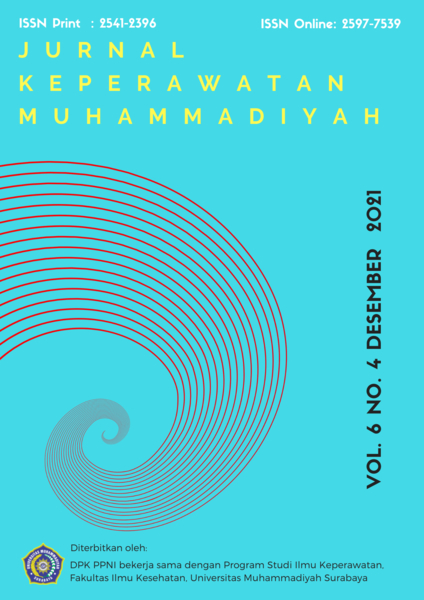Analisis Faktor Kecemasan Ibu Dalam Pendampingan Anak Belajar Di Rumah
DOI:
https://doi.org/10.30651/jkm.v6i4.11256Keywords:
Kecemasan, Pendampingan, Belajar di rumahAbstract
Objective: Â Â This study aims to determine the factors that influence maternal anxiety in assisting children to study at home / study from home.
Methods:   The design of this study used a correlational analytic design with a "cross sectional" approach, with a population of 82 people, and a large sample of 42 respondents. The sampling technique of this research uses Non Probability Sampling: Purposive Sampling. The independent variables are maternal age, child age, education level, and occupation. While the dependent variable is maternal anxiety. Collecting data using an anxiety questionnaire using the ZRAS (Zung Self-Rating Anxiety Scale). The statistical test used  the logistic regression analysis
Results: From the results of the logistic regression analysis, it was obtained education level data of 0.0.41 (<0.05) and the most dominant variable for the incidence of dementia in the elderly was a history of hypertension with p value = 0.031 (<0.05) and an OR value of 22.480 that work has a 22,480 times chance of causing anxiety in mothers .
Conclusion: Â The conclusion of this study is that the level of education and work are related to maternal anxiety. The most dominant factor affecting maternal anxiety is work which can lead to role conflict in mothers. This must be controlled with good emotional management and time management.References
Abuhammad, S. (2020) ‘Barriers to distance learning during the COVID-19 outbreak: A qualitative review from parents’ perspective’, Heliyon. Elsevier Ltd, 6(11), p. e05482. doi: 10.1016/j.heliyon.2020.e05482.
Aslan, C. (2017) ‘Eurasian Journal of Educational Research’, Eurasian Journal of Educational Research, 67, p. 37.
Atiqoh, L. N. (2020) ‘Respon Orang Tua Terhadap Pembelajaran Daring Pada Masa Pandemi Covid-19’, Thufuli : Jurnal Ilmiah Pendidikan Islam Anak Usia Dini, 2(1), p. 45. doi: 10.33474/thufuli.v2i1.6925.
Carroll, N. et al. (2020) ‘The Impact of COVID-19 on Health Behavior, Stress, Financial and Food Security among Middle to High Income Canadian Families with Young Children’, Nutrients, 12(8), pp. 1–14. doi: 10.3390/nu12082352.
Dong, C., Cao, S. and Li, H. (2020) ‘Since January 2020 Elsevier has created a COVID-19 resource centre with free information in English and Mandarin on the novel coronavirus COVID- 19 . The COVID-19 resource centre is hosted on Elsevier Connect , the company â€TM s public news and information ’, (January).
Pajarianto, H. et al. (2020) ‘Study from Home in the Middle of the COVID-19 Pandemic : Analysis of Religiosity , Teacher , and Parents Support Against Academic Stress’, 12(2), pp. 1791–1807.
Sabiq, A. F. (2020) ‘Persepsi Orang Tua Siswa tentang Kegiatan Belajar di Rumah sebagai Dampak Penyebaran Covid 19’, Ilmu Pendidikan Pkn dan Sosial Budaya, 4(1), pp. 1–7.
Spinelli, M. et al. (2020) ‘Parents’ Stress and Children’s Psychological Problems in Families Facing the COVID-19 Outbreak in Italy’, Frontiers in Psychology, 11(January), pp. 1–7. doi: 10.3389/fpsyg.2020.01713.
Sunarti, M. and Soejono, S. K. (2013) ‘Konseling Dan Mekanisme Koping Ibu Bersalin’, Journal of Educational, Health and Community Psychology, 1(1), pp. 1–27. doi: 10.12928/jehcp.v1i1.3793.
Zhao, Y. et al. (2020) ‘The effects of online homeschooling on children, parents, and teachers of grades 1-9 during the COVID-19 pandemic’, Medical Science Monitor, 26, pp. 1–10. doi: 10.12659/MSM.925591.
Downloads
Published
Issue
Section
License
- Penulis tetap memegang hak atas karyanya dan memberikan hak publikasi pertama kepada jurnal ini yang secara simultan karya tersebut dilisensikan di bawah:Â Creative Commons Attribution-ShareAlike 4.0 International (CC BY-SA 4.0)













